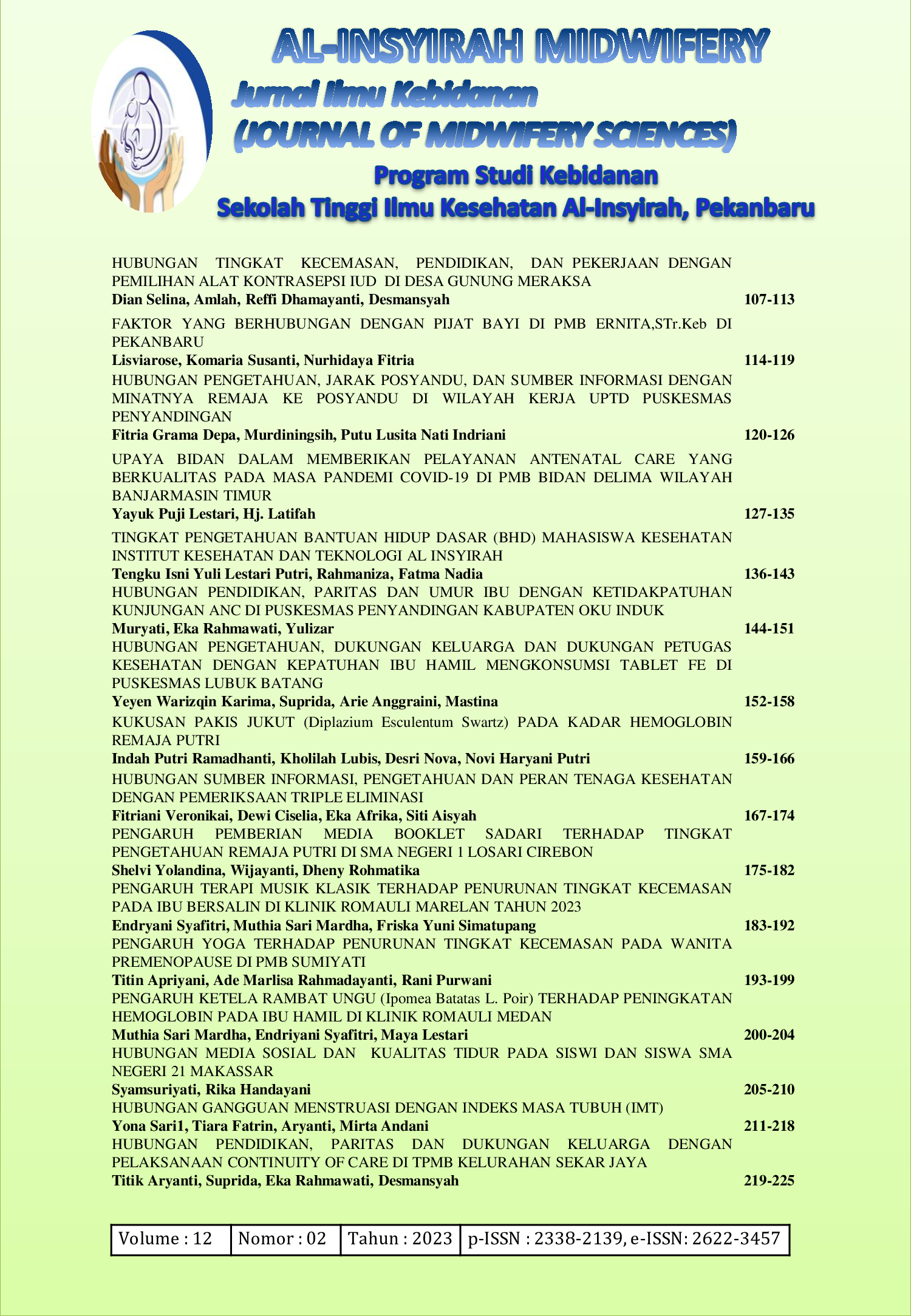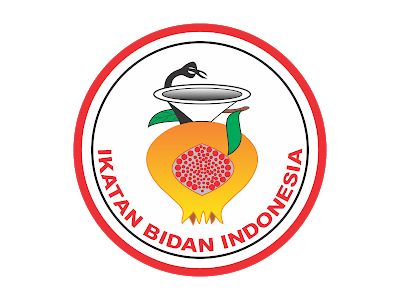HUBUNGAN TINGKAT KECEMASAN, PENDIDIKAN, DAN PEKERJAAN DENGAN PEMILIHAN ALAT KONTRASEPSI IUD DI DESA GUNUNG MERAKSA
DOI:
https://doi.org/10.35328/6n79xr88Keywords:
evel of anxiety , education, work, selection of IUD contraceptionAbstract
Intra Uterine Device or commonly known as IUD is a contraceptive in the form of a small, silastic, with a sleeve or copper wire around it that is installed in the uterus which provides long-term protection against pregnancy. The purpose of this study was to find out the relationship between anxiety levels, education, and work with the choice of IUD contraception in Gunung Meraksa Village, Lubuk Batang OKU District in 2023. This type of research was an analytic observational study with a cross sectional design or approach. The population in this study were all active family planning acceptors, totaling 385 respondents, the total sample being 80 respondents. The type of data uses primary data, the dependent variable is the selection of IUD contraception, the independent variables are anxiety level, education, and occupation. The results of bivariate research on the relationship between anxiety levels, education, and employment with the choice of IUD contraception based on the chi square statistical test anxiety level p-value 0.000 <0.05, education p-value 0.000 <0.05 and employment p-value 0.000 <0, 05 it can be concluded that there is a relationship between anxiety levels, education, and work with the selection of IUD contraception in Gunung Meraksa Village, Lubuk Batang District OKU in 2023. As for suggestions for village midwives in Gunung Meraksa village, it is expected that health workers/staff conduct education regarding IUD contraception both physically and face to face or with media that can be accessed.
Downloads
References
Anggarini et al. Pelayanan Kontrasepsi. Medan:Yayasan Kita Menulis; 2021
Azijah, I., Ambarwati, K., Ariyanti, I., Kesehatan, F. I., Indonesia, U. R., Apus, B., Timur, K. J., & Khusus, D. (2020). Pengaruh Pemberian Promosi Kesehatan Tentang Penggunaan KB IUD Terhadap Tingkat Pengetahuan Wanita Usia Subur. Jurnal Kesehatan Bakti Tunas Husada, 20, 1–7.
Dalimawaty, K. (2021). Faktor yang Mempengaruhi Minat Ibu Menggunakan KB IUD di Puskesmas Binjai Estate. Jurnal Ilmiah Kebidanan Indonesia, 4(4), 519. https://journals.stikim.ac.id/index.php/jiki/article/view/727
Dias, Q., Maulida, I. and Fitrianingsih, D. (2020) ‘Hubungan Pengetahuan tentang Kejadian Ekspulsi KB IUD dengan Kecemasan Akseptor KB IUD di Puskesmas Jatibogor Kabupaten Tegal’, SIKLUS (Journal Research Midwifery Politeknik Tegal), 3(1), pp. 1–8.
Dinas Kesehatan Prov Sumatera Selatan (2021) ‘Profil Kesehatan Provinsi Sumatera Selatan Tahun 2020’,
Dinas Kesehatan Provinsi Sumatera Selatan, p. 251.Beyer, M., Lenz, R. and Kuhn, K. A. (2006) Health Information Systems, IT - Information Technology. doi: 10.1524/itit.2006.48.1.6.
Dinkes Prov sumsel (2022) ‘Membangun Sumsel Yang Sehat Sumsel Yang Maju Untuk Semua’, Profil kesehatan provinsi sumsel 2021, p. 259. Available at: www.dinkes.sumselprov.go.id.
Dinkes Provinsi Sumsel (2019) ‘Profil Dinkes 2020 Data 2019’
Ibrahim, W. W., Misar, Y., & Zakaria, F. (2019). Hubungan Usia, Pendidikan Dan Paritas Dengan Penggunaan Akdr Di Puskesmas Doloduo Kabupaten Bolaang Mongondow. Akademika, 8 (1), 35-44.
Kemenkes RI (2022) Profil Kesehatan Indonesia 2021, Pusdatin.Kemenkes.Go.Id.Gmbh, S. B. H. (2016) ‘済無No Title No Title No Title’, pp. 1–23.
Kisid, K. M. and Wardani, R. (2021) ‘Faktor Yang Mempengaruhi Pemilihan IUD Pasca Plasenta Pada WUS di Puskesmas Wilayah Kota Mataram’, Jurnal Penelitian dan Kajian Ilmiah Kesehatan Politeknik Medica Farma Husada Mataram, 7(1), pp. 38–43. Available at: www.lppm-mfh.com.
Lidya, N., Suzana, V., & Rahmadani, S. (2020). Faktor-Faktor Yang Berhubungan Dengan Pemakaian Kontrasepsi Iud Pada Ibu Usia Reproduktif: Factors Related To The Use Of Iud Contraception On The Reproduction Of Mother's. Journal of Midwifery Science and Women's Health, 1(1), 21-26
Notoadmodjo, Soekidjo. 2018. Metodologi Penelitian Kesehatan. Jakarta: PT Rineka Cipta
Septianingrum, Y., Wardani, E. M. & Kartini, Y., (2018). Faktor-faktor yang mempengaruhi tingginya akseptor KB suntik 3 bulan. Jurnal Ners dan Kebidanan, 5(1), pp. 15-19.
Veronica, S. Y., Safitri, R. and Rohani, S. (2019) ‘Faktor - Faktor Yang Berhubungan Dengan Pemakaian KB IUD Pada Wanita Usia Subur’, Wellness and Healthy Magazine, 1(2), pp. 223–230. Available at: https://wellness.journalpress.id/wellness/article/view/v1i228wh/29
Ratna, R., Jayatmi, I., & Rini, A. S. (2023). Hubungan Sumber Informasi, Dukungan Suami Dan Tingkat Kecemasan Terhadap Keikutsertaan Akseptor Kb Iud. Sentri: Jurnal Riset Ilmiah, 2(5), 1638-1648
Downloads
Published
Issue
Section
License
Copyright (c) 2023 Al-Insyirah Midwifery: Jurnal Ilmu Kebidanan (Journal of Midwifery Sciences)

This work is licensed under a Creative Commons Attribution 4.0 International License.














